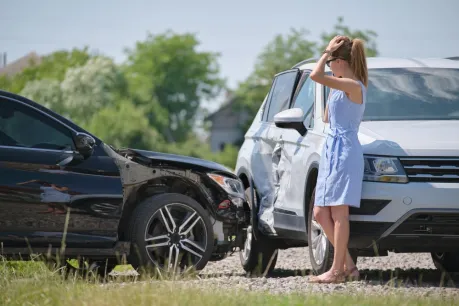T-Bone Car Accidents: What You Need to Know and How Morgan & Morgan Can Help

Injured?
T-bone car accidents, also known as side-impact or broadside collisions, are among the most dangerous types of crashes on the road. These accidents often result in serious injuries or fatalities due to the limited protection offered by the sides of vehicles.
If you or a loved one has been involved in a T-bone accident, know that you’re note alone and that you have options.
Morgan & Morgan, the nation's largest injury law firm, has extensive experience handling T-bone accident cases and securing maximum compensation for victims.
Hiring one of our lawyers is easy, and you can get started in minutes with a free case evaluation.
What Is a T-Bone Car Accident?
A T-bone accident occurs when the front of one vehicle collides with the side of another, forming a "T" shape. These accidents commonly happen at intersections when a driver fails to yield, runs a red light, or disregards stop signs. Due to the nature of the impact, the occupants of the vehicle hit on the side are at high risk of severe injury or death.
Common Causes of T-Bone Accidents
Several factors can lead to a T-bone accident, including:
- Failure to Yield – Many T-bone crashes occur when a driver does not yield the right of way at an intersection.
- Running a Red Light or Stop Sign – Drivers who ignore traffic signals and signs put others at risk of side-impact collisions.
- Speeding – High-speed collisions increase the force of impact, making T-bone crashes even more dangerous.
- Distracted Driving – Using a phone, adjusting the radio, or other distractions can cause drivers to miss critical traffic signals.
- Drunk or Impaired Driving – Alcohol and drugs impair a driver’s reaction time and decision-making abilities, often leading to deadly accidents.
- Poor Weather Conditions – Rain, snow, and fog can reduce visibility and road traction, leading to intersection crashes.
- Vehicle Malfunctions – Brake failures, faulty traffic lights, or defective vehicle parts can contribute to T-bone accidents.
Injuries Commonly Sustained in T-Bone Accidents
T-bone collisions often result in severe injuries, including:
- Head and Brain Injuries – The impact can cause concussions, traumatic brain injuries (TBIs), or skull fractures.
- Spinal Cord Injuries – Damage to the spine can lead to paralysis or long-term mobility issues.
- Broken Bones – Ribs, arms, legs, and pelvis fractures are common due to the force of impact.
- Whiplash and Neck Injuries – Sudden movement of the head can strain muscles, tendons, and ligaments.
- Internal Injuries – Damage to organs such as the liver, kidneys, or lungs can be life-threatening.
- Cuts and Lacerations – Broken glass and debris can cause serious wounds requiring surgery or stitches.
Steps to Take After a T-Bone Accident
If you are involved in a T-bone collision, follow these steps to protect yourself and strengthen your case:
- Seek Medical Attention – Even if you feel fine, injuries may not be immediately apparent. This also creates a medical record used as evidence in a personal injury claim. Follow all recommended treatments and attend all follow-up appointments.
- Call the Police – A police report will provide crucial evidence for your case.
- Gather Evidence – Take photos of the accident scene, vehicle damage, and any visible injuries.
- Obtain Witness Information – Collect names and contact details of any witnesses.
- Avoid Admitting Fault – Do not apologize or admit fault, as this can be used against you later.
- Consult a Lawyer – Contact Morgan & Morgan as soon as possible to discuss your case.
Determining Liability in a T-Bone Accident
Establishing fault in a T-bone accident is crucial for recovering compensation. Liability often depends on evidence such as traffic signals, eyewitness testimony, and accident reconstruction. Some common scenarios include:
- The At-Fault Driver Ran a Red Light or Stop Sign – If the other driver ignored traffic signals, they are likely liable for the accident.
- Failure to Yield – A driver who fails to yield the right of way at an intersection may be held responsible.
- Shared Fault – In some cases, both drivers may share liability if both contributed to the crash.
- Third-Party Liability – In rare cases, defective traffic lights or road conditions may make a municipality or vehicle manufacturer partially liable.
Morgan & Morgan’s experienced attorneys investigate all aspects of the crash, gathering crucial evidence such as surveillance footage, witness statements, and police reports to establish fault.
Protect Yourself on the Road: Get UM/UIM Insurance
Did you know that in Florida, juries aren’t allowed to know if a defendant has insurance? That means if you're in an accident caused by an uninsured or underinsured driver, you could be left paying the price.
To protect yourself, make sure you carry Uninsured/Underinsured Motorist (UM/UIM) coverage—and don’t forget to stack your coverage for maximum protection. An umbrella policy can also provide an extra layer of security.
Don’t take chances with your future. Get the right coverage today—because when the unexpected happens, you’ll want to be covered.
How a T-Bone Accident Lawyer at Morgan & Morgan Can Help
The legal team of experienced experts at Morgan & Morgan fights to maximize compensation to help our clients move forward with their lives. This includes:
Investigating the Accident
Our legal team thoroughly investigates the accident, collecting essential evidence such as:
- Traffic camera footage
- Police reports
- Witness statements
- Medical records
- Accident reconstruction analysis
Determining Liability and Proving Negligence
We work to prove the other driver’s negligence by demonstrating:
- Duty of care – The driver had a responsibility to obey traffic laws.
- Breach of duty – The driver violated traffic rules or drove recklessly.
- Causation – Their negligence directly caused the accident.
- Damages – You suffered injuries and financial losses as a result.
Negotiating With Insurance Companies
Insurance companies often attempt to minimize payouts. Our attorneys handle negotiations to ensure you receive fair compensation for:
- Medical expenses
- Lost wages
- Pain and suffering
- Property damage
- Future medical care
Filing a Lawsuit if Necessary
If a fair settlement cannot be reached, our trial attorneys are prepared to take your case to court and fight for your rights.
Maximizing Compensation
We calculate the full extent of your damages, ensuring you receive the maximum compensation possible to cover both economic and non-economic losses.
Why Choose Morgan & Morgan?
Morgan & Morgan has been fighting for injury victims for over 35 years. With over 1,000 attorneys nationwide and offices in every state, we have the resources to take on even the toughest cases as the nation’s largest personal injury law firm.
We have secured over $23 billion fighting For the People and have gained a reputation for never backing down from a fight.
If you or a loved one has been injured in a T-bone accident, don’t wait to seek legal help. Contact Morgan & Morgan today for a free, no-obligation case evaluation. Our experienced attorneys are ready to fight for the compensation you deserve.

We've got your back
Injured?
Not sure what to do next?
We'll guide you through everything you need to know.

